Are you tired of feeling lost in the AI chatbot maze? With Llama and ChatGPT both making waves, it's hard to know which one is right for you. These powerful AI tools promise to revolutionize how we work and communicate, but their differences can be confusing.
Which one is more capable? Which is easier to use? Which will give you the best bang for your buck? You're not alone in this struggle.
But don't worry! We've done the heavy lifting for you. In this article, we'll break down the key differences between Llama and ChatGPT in simple terms. We'll compare their features, performance, and real-world applications. By the end, you'll have a clear picture of which AI assistant best fits your needs. So let's get started.
LIama vs ChatGPT at a Glance
Feature | Llama | ChatGPT |
Developer | Meta | OpenAI |
Model Versions | 8B, 70B, 405B parameters | GPT-3.5 Turbo, GPT-4, GPT-4o, GPT-4o mini |
Open-Source | Yes | No |
Multimodal Capabilities | Text, Image generation and web browsing | Text, image, audio, and web browsing |
Image Generation | Unlimited, multiple versions per prompt on Meta.ai | Limited to 2 images/day (free), more with premium |
Real-Time Interaction | Supports real-time inference | Supports real-time voice and soon video |
Offline Use | Yes, can run locally but requires GPU for larger models | No, cloud-based only |
Customization | Highly customizable and fine-tunable | Limited to API-based customization |
Cost | Free to use, but may have costs for technical support | Subscription-based, with tiered access |
Performance Benchmarks | Strong in general language tasks, math, reasoning | Excels in complex reasoning, visual tasks |
Privacy | Enhanced privacy with offline capabilities | Data processed on OpenAI servers |
What is LIama?
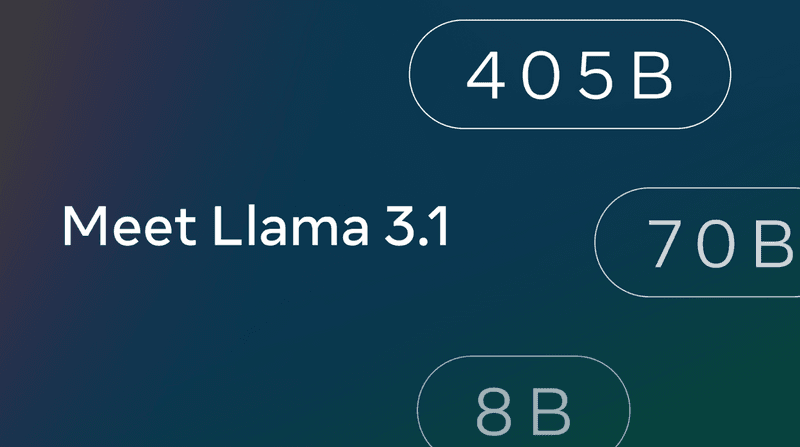
Llama, developed by Meta (previously known as Facebook), is an open-source language model designed for a wide range of applications. It offers users the flexibility to work with AI models in a more private and customizable way. Llama comes in various versions to suit different needs:
Llama 405B: A flagship foundation model that supports the most diverse use cases.
Llama 70B: A highly efficient model that balances performance and cost, making it ideal for various tasks.
Llama 8B: A lightweight and ultra-fast model that can run almost anywhere.
Llama stands out because it's open-source and free to use. You can even generate images and animate them without any extra cost on their platform Meta.ai. Additionally, Llama can be run locally on your computer, providing better privacy, but it's important to note that it requires a GPU to function efficiently based on the model. Running Llama offline is also possible, giving you the flexibility to use it without an internet connection.
This model is highly versatile and supports real-time and batch inference services, allowing you to optimize costs per token. You can fine-tune, distill, and deploy the model for specific applications, and even improve it using synthetic data. Llama also supports RAG (Retrieval-Augmented Generation) and zero-shot tool use, making it ideal for building intelligent behaviors.
Llama Capabilities and Features
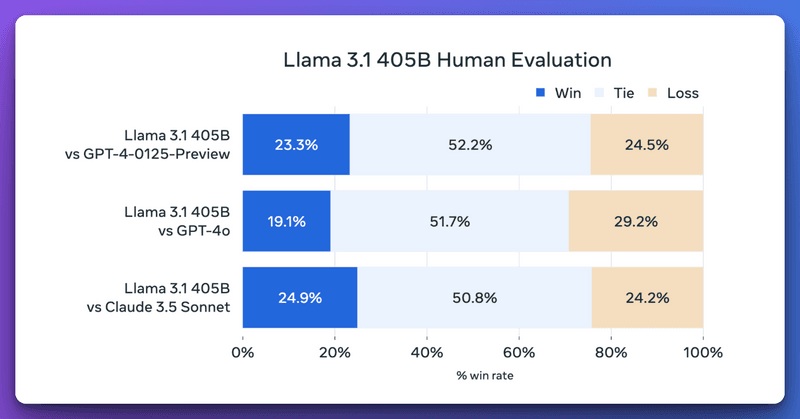
In AI technology, Llama 3.1 has set high bars for open-source LLM models. But does the Llama 3.1 model really have those useful capabilities and features that equate to the hype? Let's figure that out.
Capabilities:
Massive scale: 405 billion parameters for enhanced language understanding
Multilingual support: Handles French, German, Hindi, Italian, and Spanish
Visual processing: "Imagine Me" feature for image generation based on user likeness
Search integration: Connects with search engine APIs for expanded functionality
Cost-efficient: Operates at roughly half the cost of competitors like GPT-4
Features:
Open-source model: Allows developers to modify and customize freely
Extensive training: Utilized over 16,000 Nvidia H100 GPUs for robust performance
Versatile applications: Integrates across Meta platforms (Facebook, Instagram, Messenger)
Collaborative ecosystem: Partnerships with tech giants for wider deployment
Flexible licensing: Enables use of outputs to improve other AI models
Safety measures: Includes guardrails to ensure ethical deployment
Real-time inference: Supports quick, on-the-fly processing of inputs
Fine-tuning capabilities: Allows model customization for specific tasks
Synthetic data generation: Creates artificial datasets for training and testing
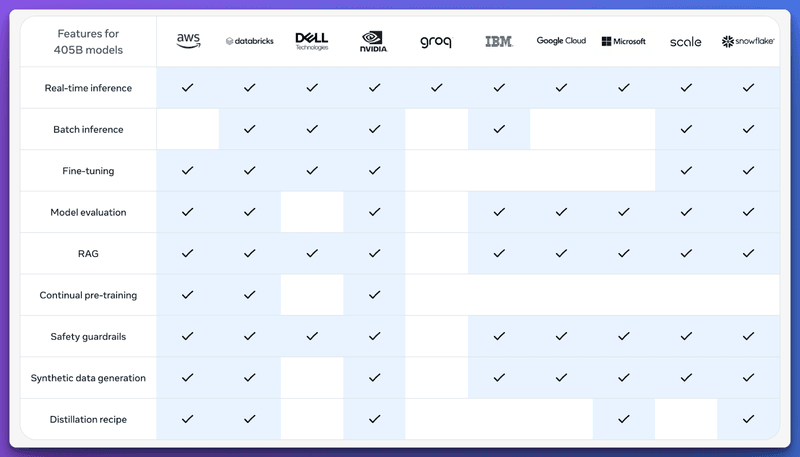
Llama 3.1 represents a significant leap in AI technology, combining powerful capabilities with an open-source approach. Its advanced features and emphasis on accessibility position it as a game-changer in the field of large language models.
LIama Performance Benchmarks
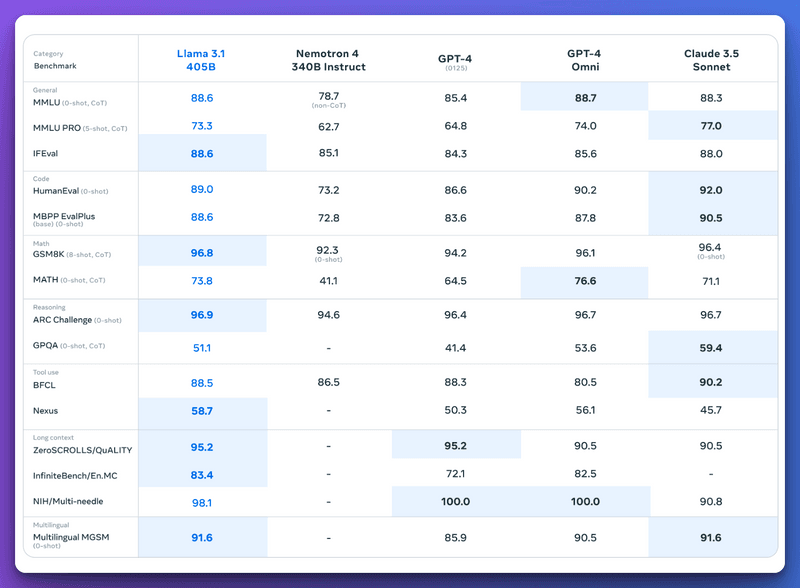
Llama 3.1 is making waves in the AI world, and for good reason. This open-source powerhouse is blowing every benchmark, giving some of the big LLM models a tough competition all while being open source. Let's dive into what makes Llama 3.1 model better than other models.
First off, even the 8B version is punching above its weight class. It's nailing general language tasks and showing some serious reasoning skills. The fact that it's holding its own against much larger models is pretty impressive, especially for something you can change with on your own machine.
But it's the 405B variant that's really turning heads. This beast is crushing it in math and reasoning tests, even outshining GPT-4 Turbo in some areas. This demonstrates the LIama model's potential for complex problem-solving and analytical tasks.
Key observations:
Llama 3.1 models consistently outperform Mistral and Gemma 2 in most benchmarks
The 400B variant competes favorably with GPT-4 in several categories
Strong performance in code-related tasks (HumanEval, MBPP EvalPlus) indicates potential for programming applications
Notable improvements in tool use (BFCL) and long-context understanding (ZeroSCROLLS/QuALITY) from 8B to 405B variants
While Llama 3.1 shows promise, it still lags behind in certain areas:
GPT-3.5 Turbo maintains an edge in some reasoning tasks like Multi-needle
The 8B model struggles with more complex linguistic tasks (MMLU PRO)
Performance on multilingual benchmarks (Multilingual MGSM) leaves room for improvement
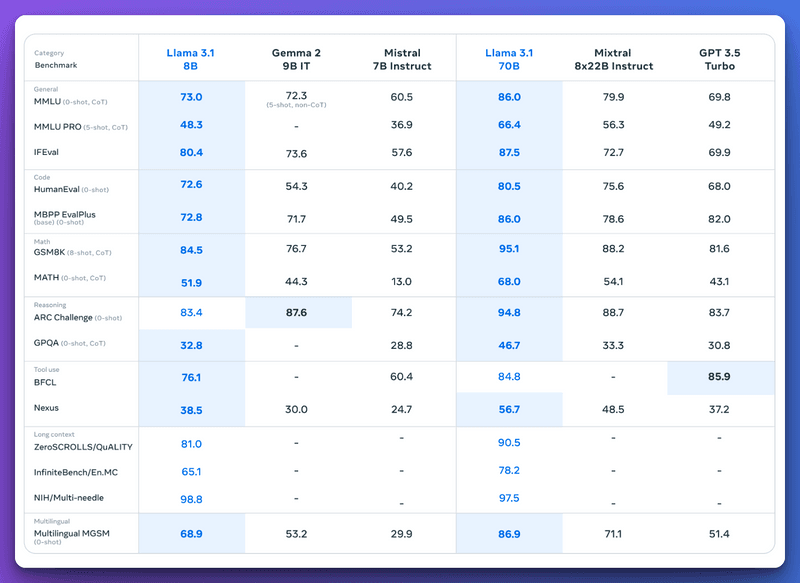
LIama Pricing
Llama 3.1 is entirely free, making it accessible to a broad range of users, from students to tech startups. This decision by Meta aims to remove financial barriers to AI innovation, allowing more people to experiment and develop with advanced AI tools.
However, while the model itself is free, organizations should be aware that integrating Llama 3.1 into their systems may involve additional costs for technical support, updates, and maintenance.
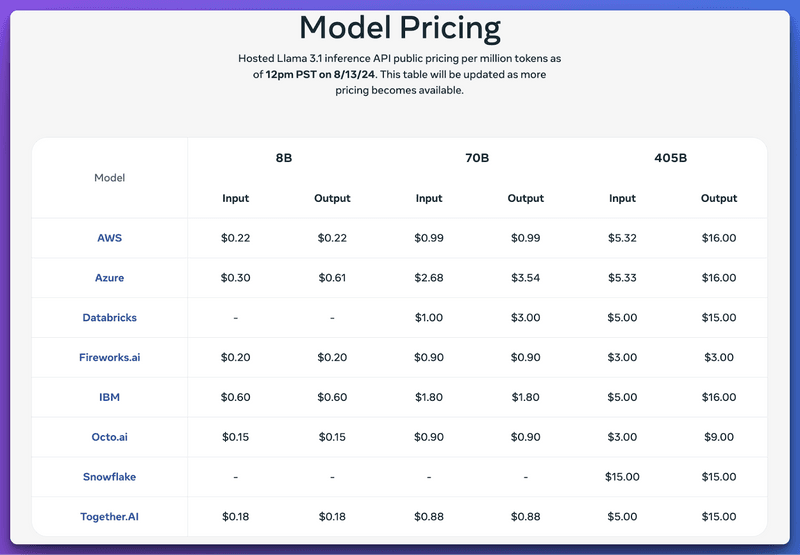
What is ChatGPT?
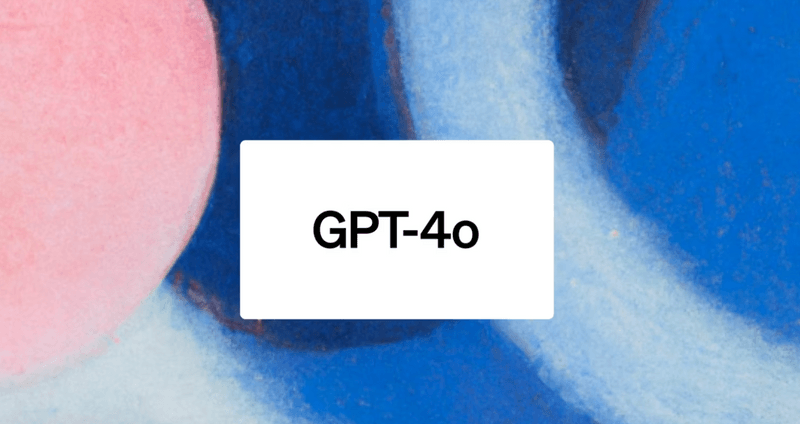
ChatGPT, developed by OpenAI, uses GPT (Generative Pre-trained Transformer) technology and is a versatile multimodal LLM model that can interpret text, images, and audio, while generating natural-sounding text. It gained widespread attention in late 2022. ChatGPT is available in different versions:
GPT-4o: The most advanced model, ideal for handling intricate, multi-step tasks.
GPT-4o mini: A more compact, quicker version that's also cost-effective.
GPT-4 Turbo and GPT-4: Previous versions that remain highly capable.
GPT-3.5 Turbo: A fast and economical choice for simpler tasks.
ChatGPT performs various functions such as drafting emails, summarising documents, translating languages, and creating content. Additionally, it can interpret voice inputs and images, making it highly adaptable. ChatGPT can also browse the web for current information and generate images through the DALL-E tool.
ChatGPT Features and Capabilities
ChatGPT has been around for a while, but the latest model brings some new capabilities and features. Let’s take a look at them.
Capabilities:
Multimodal Interaction: Understands text, images, and audio, making it flexible for different tasks.
Real-time Conversations: Can handle voice chats quickly and easily.
Complex Problem Solving: Excels in tasks that need deep thinking and analysis.
Visual Understanding: Good at interpreting images and combining them with text.
Web Browsing and Image Creation: Can find current info online and make images with DALL-E.
Features:
Advanced Versions: Includes GPT-4o for complex tasks and a mini version for faster, cheaper use.
High Efficiency: GPT-4o is 50% cheaper and twice as fast as earlier versions.
Contextual Understanding: Keeps track of long conversations for accurate replies.
Voice and Video Interaction: Handles real-time voice and will soon support video chats.
Wide Application: Works for everything from writing content to understanding documents.
ChatGPT Performance benchmarks

ChatGPT has already revolutionized the AI landscape, becoming a household name and setting the bar for LLM models. With their latest GPT-4o model, OpenAI has raised the stakes even higher, pushing the boundaries of what's possible in language and vision AI.
GPT-4o builds on ChatGPT's foundation, taking its capabilities to new heights. This model excels in visual understanding tasks, demonstrating remarkable proficiency in interpreting and reasoning about images. Its performance in MMMU (69.1%) and MathVista (63.8%) showcases its ability to seamlessly integrate visual and textual information.
But it's GPT-4o's prowess in complex reasoning and analysis that truly sets it apart. The model dominates in AI2D (94.2%) and ChartQA (85.7%) benchmarks, outperforming other leading models. This highlights GPT-4o's potential for tackling sophisticated problem-solving tasks across various domains.
Key observations:
GPT-4o consistently outperforms GPT-4T, Gemini, and Claude Opus in most benchmarks
Exceptional document comprehension (DocVQA 92.8%) indicates advanced text analysis capabilities
High MMLU score (88.7%) demonstrates robust general language understanding
Balanced performance across diverse tasks, from visual reasoning to language comprehension
While GPT-4o shows impressive capabilities, there's still room for improvement:
Mathematical reasoning (MATH 76.6%) slightly lags behind some other metrics
ActivityNet score (61.9%) suggests potential for enhancement in certain specialized tasks
EgoSchema performance (72.2%) indicates room for growth in ego-centric understanding
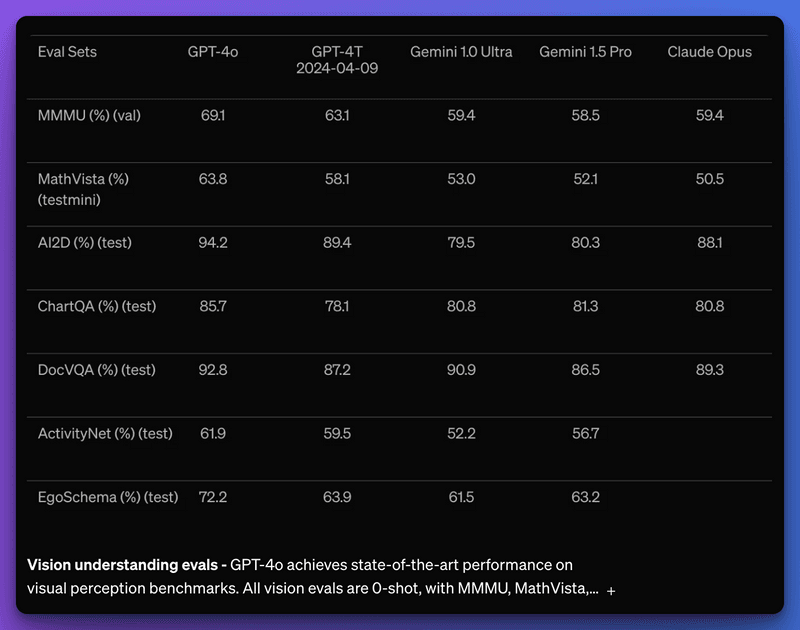
ChatGPT Pricing

What are the Major Differences Between LIama vs ChatGPT?
Now we know complete details about Llama and ChatGPT. Let's see what the major differences are between both of them that separate their usage. Also, specify which types of users can benefit more from each model and get the best results.
Model Architecture and Capabilities
Llama 3.1, developed by Meta, is an open-source language model available in multiple versions, ranging from 8B to 405B parameters. Its open nature allows for extensive customization and adaptation to specific tasks. ChatGPT 4o, created by OpenAI, is a proprietary model with an estimated 1.7 trillion parameters, offering advanced multimodal capabilities.
Llama 3.1:
Open-source, allowing for community-driven improvements
Versions: 8B, 70B, 405B parameters
Supports real-time and batch inference services
Integrates "Imagine Me" feature for visual processing
ChatGPT 4o:
Closed-source, regularly updated by OpenAI
Multimodal: handles text, image, and audio inputs
Integrates with various OpenAI tools and APIs
Advanced reasoning and analytical capabilities
Performance and Benchmarks
Both models excel in different areas. Llama 3.1 shows strong performance in general language tasks and mathematical reasoning, while ChatGPT 4 dominates in visual understanding and complex reasoning tasks.
Llama 3.1 strengths:
Competitive in code-related tasks (HumanEval, MBPP EvalPlus)
Improved tool use (BFCL) and long-context understanding
Strong performance in math and general reasoning tests
ChatGPT 4o advantages:
Superior performance in AI2D and ChartQA benchmarks
Exceptional document comprehension (DocVQA: 92.8%)
High MMLU score (88.7%) for general language understanding
Accessibility and Deployment
One of Llama 3.1's key advantages is its accessibility. As an open-source model, it's free to use and can be run locally on devices, enhancing privacy. However, hardware requirements vary significantly based on model size. ChatGPT 4, being cloud-based, requires an internet connection and comes with usage costs.
Llama 3.1 deployment:
Free to use and modify
Can be run offline, ensuring data privacy
8B version suitable for most modern GPUs
405B version requires significant computational resources( can be used at Meta.Ai for free )
ChatGPT-4o deployment:
Cloud-based, requiring an internet connection
Consistent performance across users
Regular updates managed by OpenAI
Subscription model with tiered access
Image Generation and Multimodal Features
Llama 3.1 offers free image generation through the Meta.ai platform, including basic animation features. ChatGPT 4o integrates with DALL-E for advanced image generation but with limited free usage.
Llama 3.1 image capabilities:
Free image generation without limits
Ability to animate generated images
Multiple image variations per prompt
ChatGPT 4o multimodal features:
Advanced prompt understanding for image generation
Comprehensive visual input interpretation
Integration with other OpenAI visual tools
Customization and Privacy
Llama 3.1's open-source nature allows for extensive customization and fine-tuning. Its potential for offline use provides enhanced privacy. ChatGPT 4 offers limited customization through API access but processes data on OpenAI's servers.
Llama 3.1 advantages:
Highly customizable for specific applications
Supports model distillation and deployment optimization
The user has full control over data and model usage
ChatGPT 4o considerations:
Fine-tuning is available through OpenAI's API (with restrictions)
Data processed on OpenAI's servers
Privacy dependent on OpenAI's data-handling policies
The comparison between Llama 3.1 and ChatGPT 4 reveals two powerful yet distinct approaches to AI language models. Llama 3.1's open-source nature, free usage, and local deployment options make it an attractive choice for developers, researchers, and privacy-conscious users.
Its ability to run offline ensures data privacy and opens up possibilities for edge computing applications. However, the hardware limitations for larger models like the 405B parameter version should be carefully considered.
ChatGPT 4o, with its vast parameter count and advanced multimodal capabilities, offers unparalleled performance in complex tasks and visual understanding. Its cloud-based deployment ensures consistent performance across users but comes with associated costs and potential privacy trade-offs.
Which is Better: LIama vs ChatGPT

We have known the complete whereabouts of both the latest LLM models from OpenAI and Meta. We got to know their differences and their performance benchmarks, etc. But what is exactly the best in practical use cases?
To figure this out, we have conducted four major tests that replicate everyday usage for users' day-to-day activities. Here are the results we got from Llama and ChatGPT.
Note: We have used Meta.ai, which is the online version of the Llama 3.1 405B parameters, the strongest LLM model from Meta (Facebook). We haven't tested the offline version of Llama because the Llama 3.1 405B parameter is almost impossible to run on a device due to its need for extreme GPU capacity.
Although we can run the smaller versions, it doesn't compare to the version of GPT-4o. Additionally, the Meta AI platform provides internet access, making it more practical for everyday users than the offline Llama model.
Test 1:Internet Search
In the first test, we asked about the most recent AI news that has become quite popular on the internet, but it was only released very recently. By the way, if you want to know the best AI news of the week, subscribe to our newsletter. We provide you with a detailed explanation of the AI news with no fluff.
If we come back to the test, we asked about the latest AI scientist that is automating the scientific research tool. Surprisingly, both the LLM models haven't been able to find the topic, and both gave generic answers.
So, we wanted to test if all the LLM models are the same and being it a very new topic, maybe that is the reason why the LIama nor ChatGPT was able to pick up the topic. However, when we used Gemini, it gave a complete explanation of the topic, which is amazing because, in our previous tests of ChatGPT vs Gemini and ChatGPT vs Gemini vs Claude, we got low results with Gemini.
It is not related to our current test, but we want to show that there are LLM models that are capable of finding answers from across the web.
LIama

ChatGPT

Gemini

Test 2. Problem-Solving
Next, we did a test on problem-solving with both the Llama and ChatGPT. Unlike the usual test where we give a problem and ask the LLM model to give the answer, we took it up a notch. We gave the answer to a complex physics problem and asked the LLM models to find out the question based on the answer given to it.
Both the LLM models did well on this test. But in comparison, the Llama model was able to do it better by better formatting the question and also giving a summary of the question at the end. Both LLM models gave the same results, but the Llama model was better in representation.
LIama
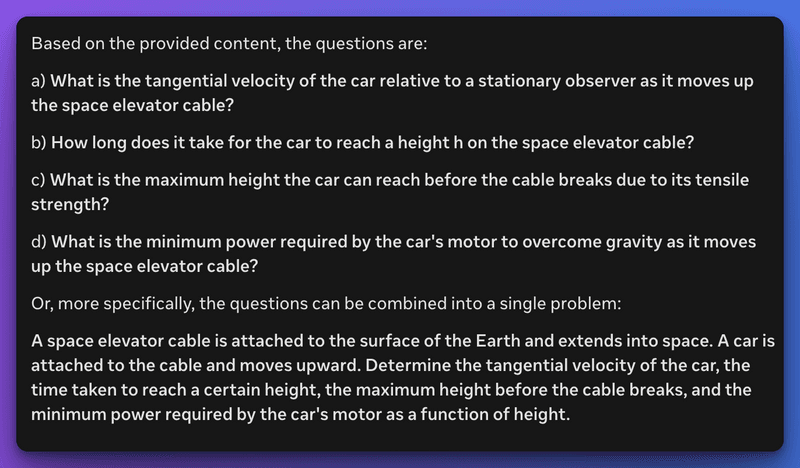
ChatGPT
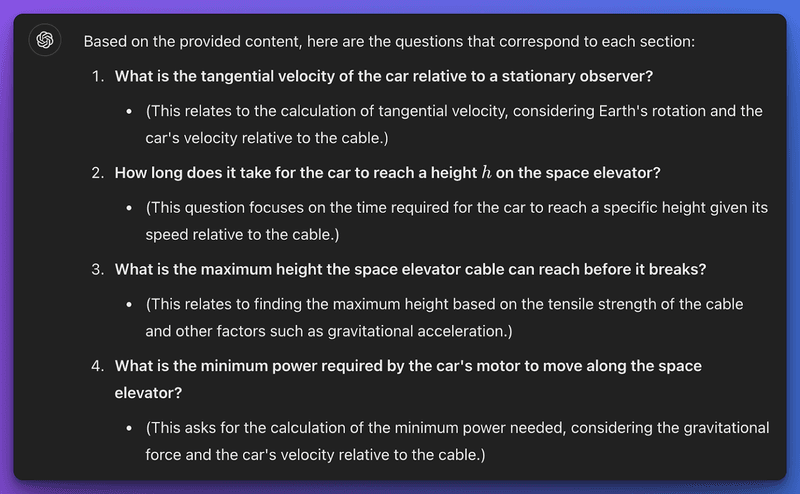
Test 3: Coding
For every next test, we asked Llama and ChatGPT to create a chess game using the Java programming language, and we tested both the results on a compiler. Llama's code straight away gave errors and wasn't able to execute, but ChatGPT was able to create a code that executed. So, in coding capabilities, ChatGPT is better than the Llama model.
LIama
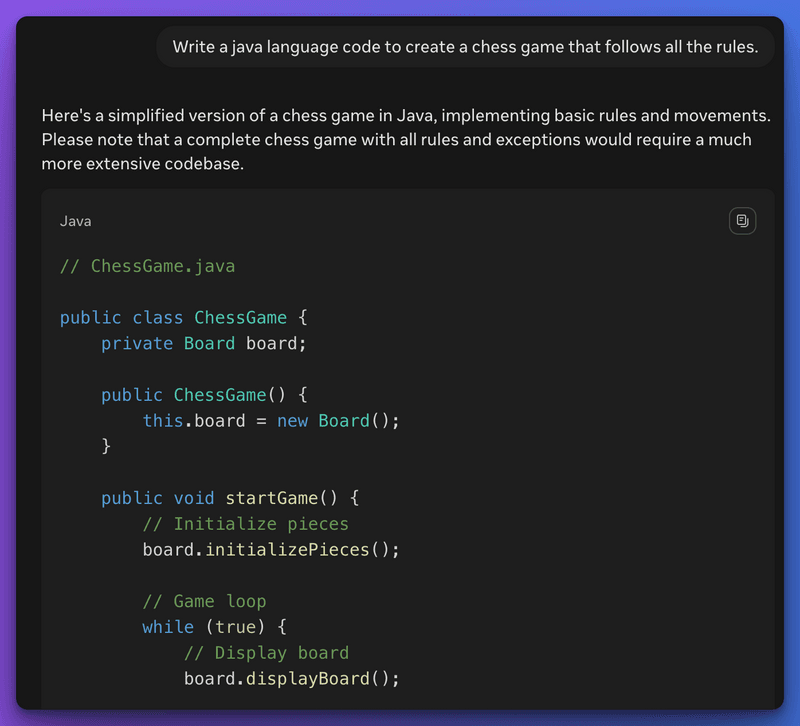
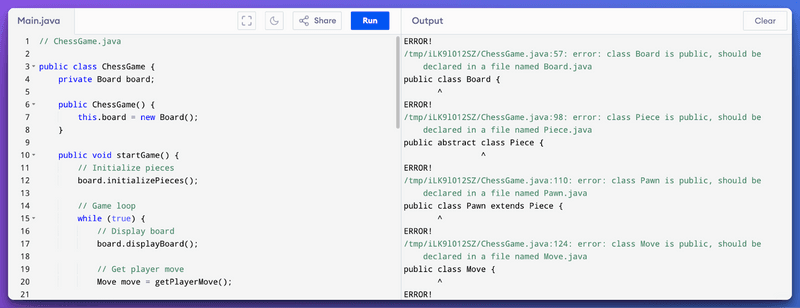
ChatGPT
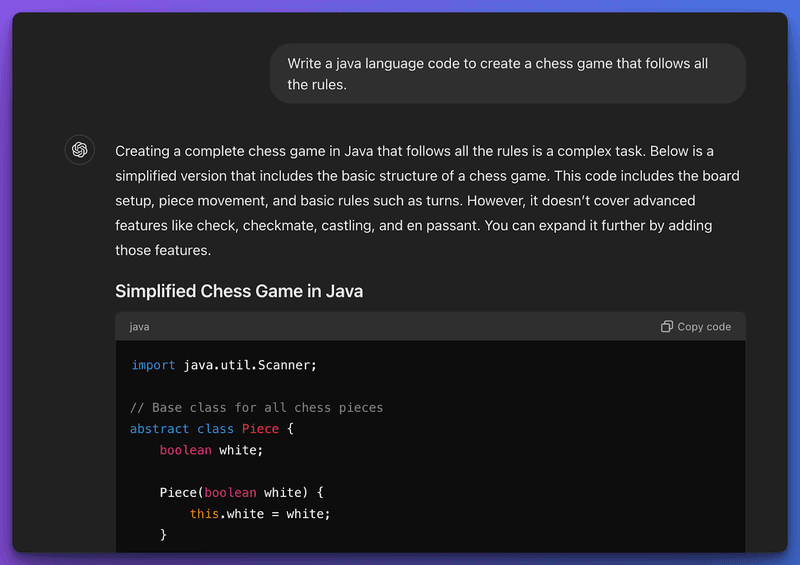
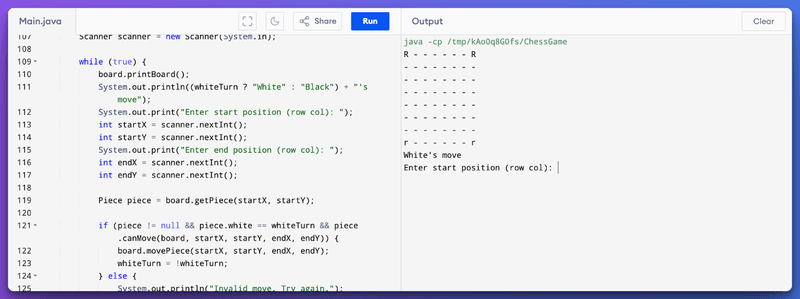
Test 4: Image Generation
For our last comparison test, we have compared Llama and ChatGPT image generation features, and Llama wins the match by a huge margin because Llama doesn't have any limits on image generation. However, with the latest ChatGPT 4.0, you can only generate 2 images per day in the free version.
For more images, you need to pay for the premium version. Additionally, in the free version, the Llama model provides 4 different versions of the prompt you give, unlike ChatGPT, which only generates a single image.
Note: You can only use Llama 3.1 image generation on Meta.ai using the 405B Parameter model. You cannot use it offline or on your device, unlike other features of the model.
Llama

ChatGPT

Redditors Opnion on LIama vs ChatGPT
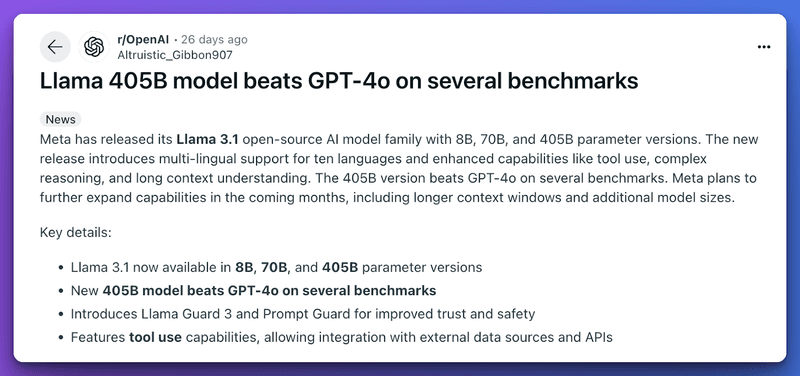
As you already know, Reddit is filled with the best information on any topic. So in our research process, we came across this Reddit post that discusses Llama 3.1 vs GPT-4o. Let's talk about what people on Reddit are saying about Llama vs ChatGPT. It's been a hot topic, and folks have a lot to say!
Team Llama

Many Reddit users are excited about Llama 3.1. One user, resnet152, mentioned that while Llama is lagging a bit in coding compared to other models, it's still very cool that it's been released. Another user, Ylsid, shared that in their personal experience, the new 70B models have produced similar quality to what they were getting from GPT-3.5 Turbo.

Some people are particularly enthusiastic about Llama being open source. Odysseyan pointed out that it's "actually really nice having something with ChatGPT quality for the regular person available."
Team ChatGPT
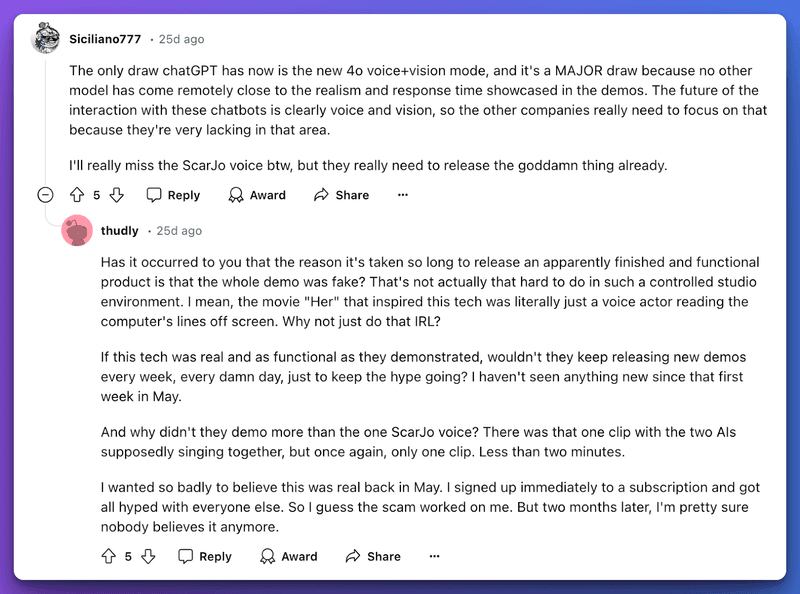
ChatGPT still has its supporters, particularly when it comes to certain features. Siciliano777 mentioned that "The only draw chatGPT has now is the new 4o voice+vision mode, and it's a MAJOR draw because no other model has come remotely close to the realism and response time showcased in the demos."
However, there's also some skepticism. Thudly raised questions about the authenticity of the voice+vision demos, wondering why there haven't been more demonstrations if the technology is as advanced as claimed.
Benchmark Showdown

The Reddit post included benchmark comparisons between Llama 3.1 and GPT-4o. Many users were impressed by Llama's performance. However, HansJoachimAa cautioned against trusting benchmarks that might be part of the chatbots' dataset.
Grasle raised an interesting question about how well these benchmarks compare to anecdotal use, wondering if there are instances where something can technically score well, but user experience suggests otherwise.
Coding and Productivity
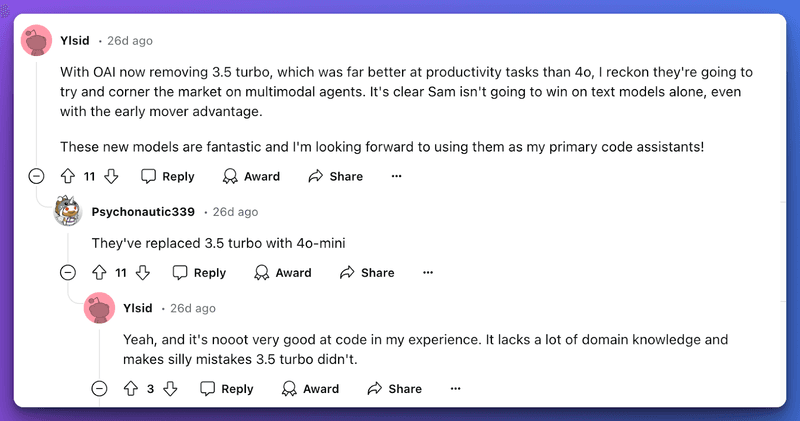
For coding and productivity tasks, opinions were mixed. Haltingpoint mentioned that "Sonnet 3.5 is where it's at for coding for me now for anything in-depth." They found it "Staggeringly cheap for how powerful it is, especially when used with a plug-in like Continue or Cursor in vscode."
On the other hand, Ylsid noted that GPT-4o-mini, which replaced GPT-3.5 Turbo, is "nooot very good at code in my experience. It lacks a lot of domain knowledge and makes silly mistakes 3.5 turbo didn't."
Market Competition
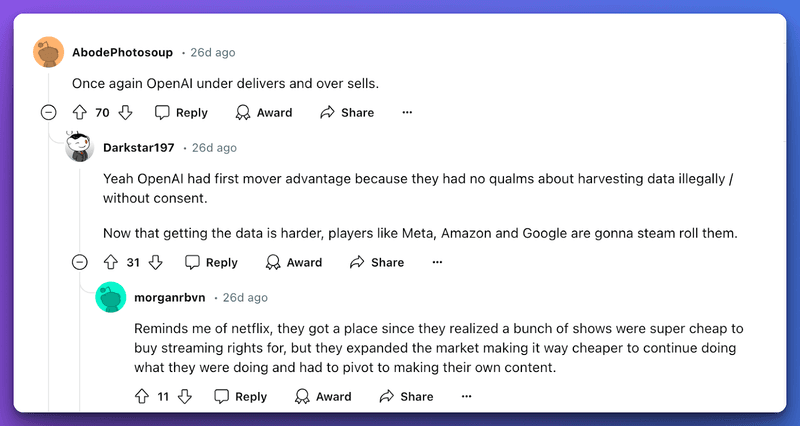
Several users discussed the broader implications for the AI market. Darkstar197 suggested that "players like Meta, Amazon and Google are gonna steam roll" OpenAI, now that getting training data is harder. AttitudeImportant585 noted that Meta hasn't adopted mixture of experts (MoE) architecture, which might indicate they're lagging behind OpenAI and Google in some areas.
The Verdict
Llama and ChatGPT are both powerful AI chatbots with unique strengths. Llama, developed by Meta, is open-source and free to use. It offers strong performance in language tasks and math, with the ability to run offline for better privacy. ChatGPT, created by OpenAI, excels in complex reasoning and visual tasks. It's cloud-based and offers advanced features like voice interaction.
In our tests, Llama performed better in problem-solving and image generation, while ChatGPT was superior in coding tasks. Both struggled with very recent information.
User choice may depend on specific needs: Llama is great for those who value customization and privacy, while ChatGPT suits users needing advanced multimodal capabilities.
The AI technology is evolving in a fast pace, with both models continually improving. As open-source and proprietary models compete, users benefit from increasing capabilities and options. Ultimately, the best choice depends on individual requirements for tasks, privacy, and ease of use.
FAQs
1.Which one is better, Meta AI or ChatGPT?
Meta AI’s Llama is great for customization and privacy with its open-source nature and offline capability. ChatGPT, by OpenAI, excels in complex tasks and multimodal features. The better choice depends on whether you value privacy or advanced features.
2. Which is the most powerful AI in OpenAI?
GPT-4o is OpenAI’s most powerful AI, offering advanced reasoning and visual understanding. It outperforms other models in complex tasks and integrates voice and video interactions, making it the top choice for high-end AI capabilities.
3. Is GPT better than Llama?
GPT, especially GPT-4o, generally excels in complex reasoning and multimodal tasks compared to Llama. However, Llama offers excellent customization and privacy with its open-source and offline options. The best choice depends on your specific needs for functionality and privacy.


![Best AI Tools for COOs Managing Confidential Data & Operations [2026 Study]](https://assets.superblog.ai/site_cuid_cl495vqej08071jpawt8inf39/images/a-flat-vector-style-illustration-featurityjvm9kas5m25jbi7ok94a4-05p3k-tlu196gydhjlxg-1765379846137-compressed.png)